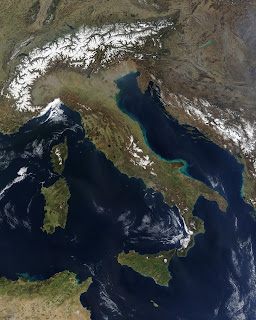There can be gorgeous valleys with waterfalls and lots of agriculture, and then there are Volcanoes that inspired novels.
 |
| Stromboli Volcano off the coast of Italy was the insipiration for Mordor in the Lord of the Rings |
 |
| Trevi Fountain, Rome, Italy |
Italy literally has just about everything to offer. It was the start of the Renaissance artistic period, and for a while it was the center the world. (Not geographically speaking).
 |
| Ancient Roman ship buried in silt recently dug up in Pisa, Italy. |
In some places like Pisa, the grounds are sinking in and will eventually suck in the buildings.Pisa is silting in, which is the process when sediments are moved by water and deposited on land. Eventually, so much silt will be deposited inland and bury and Pisa. Not that long ago, as a matter of fact, while digging through silt in Pisa, 9 ancient ships were found buried and are now on display.
 |
| Cinque Terre, Italy is slowly silting in. |
But if Pisa is starting to silt in, then what will happen to the rest of the country over time?
 |
| Lipari Island, Messina, Italy. The huge square blocks in from of the island are from revetment. Placing large blocks or rocks in front of the shore line stops silt from imposing the land. |
1,000 Years Into the Future
By this time Pisa will be gone and silted under. Without revetment to stop the sand from flowing in, Pisa will be buried.
The coasts will slowly be eaten away. With the water intruding the land, higher cliffs will gain wave cut notches from the water digging into the side of the rock. when these notches get too large, the cliff will collapse and be laid into the water.
 |
| Wave cut Notch. Eventually, the base won't be strong enough to support the top and it will collapse. |
 |
| Sea Arch in Ponzo, Italy. The wall gave out in this portion due to weak sediments and fell into the water. |
The current Ice Age we're in will be concluded and the world will start to heat up. The ice caps and glaciers will have mostly melted causing sea level rising. With increased sea level rising, the silting will have moved further and further inland. the higher elevated land by the water will soon become sea stacks.
If you were to go into the Appenine mountains, you'd find that they have even hotter summers. The climate of Italy is due mainly to the mountains themselves. The Po River attributes to about 70% of lower Italy. The river will have a massive flood because of temperature increase and be followed with heavy unforgiving rains. The mountains will increase in size due to converging and the clouds will accumulate on top of the mountains. These powerful storms will rip down the sides of the Apennines and create thick lush plants that can survive at the base of the mountains and towards the beaches.
1,000,000 Years Into the Future
Hopefully by this time, the Earth is at the end of another Ice Age as we are today. After the ice caps freeze again the water levels will recede. In Italy, most of the beaches would be silted over, but we'd see these nice wave cut platforms that would have happened over the last million years.
 |
| Sea cut platform process. |
These sea cut platforms will begin to shape Italy again as it once was. Pisa will still be covered by sand and be buried, but the water above it from before will now be gone and flat. New Volcanoes will have risen from the ocean, whereas our old ones would have detonated and collapsed. Places like Sicily that had been flooded out due to the end of the last ice age will now be uncovered and plants will begin to thrive on the new island.
Africa, being divergent from Saudi Arabia will move up closer and closer to Italy, which will be moving more into central Europe. The mountains will greatly increase in height, and due to the African plate pushing into the country, it will move back the western side will connect with Croatia, Bosnia, and Albania. Italy will get colder due to moving north and will eventually converge with the entire continent to no longer become a peninsula. The Mediterranean sea will shrink in size with Africa imposing north.
In Conclusion
Italy is a ridiculously weird country. Originally it broke apart from Central Europe into the Mediterranean sea. I believe that it will go back to the way it almost was, however, the Appenine Mountains will grow larger due to the African and Eurasian plates colliding and pushing the country north. Within the first 1000 years, not too much will happen, just silting in the beaches. After that with the ice age ending, silting will increase and the the Mediterranean will rise, taking over lower Italy and making the country a lot hotter more rainy. After that, the country will be located more north, however the land will look a lot like it does today towards the beaches and right next to the mountains because of the lower sea levels. Italy will still have many different types of habitats and areas that are unique only to their country, and it will still be just as beautiful, even 1,000,000 years later.
 |
| Manarola, Italy. Part of the Cinque Terre |

















.png)
.jpg)















